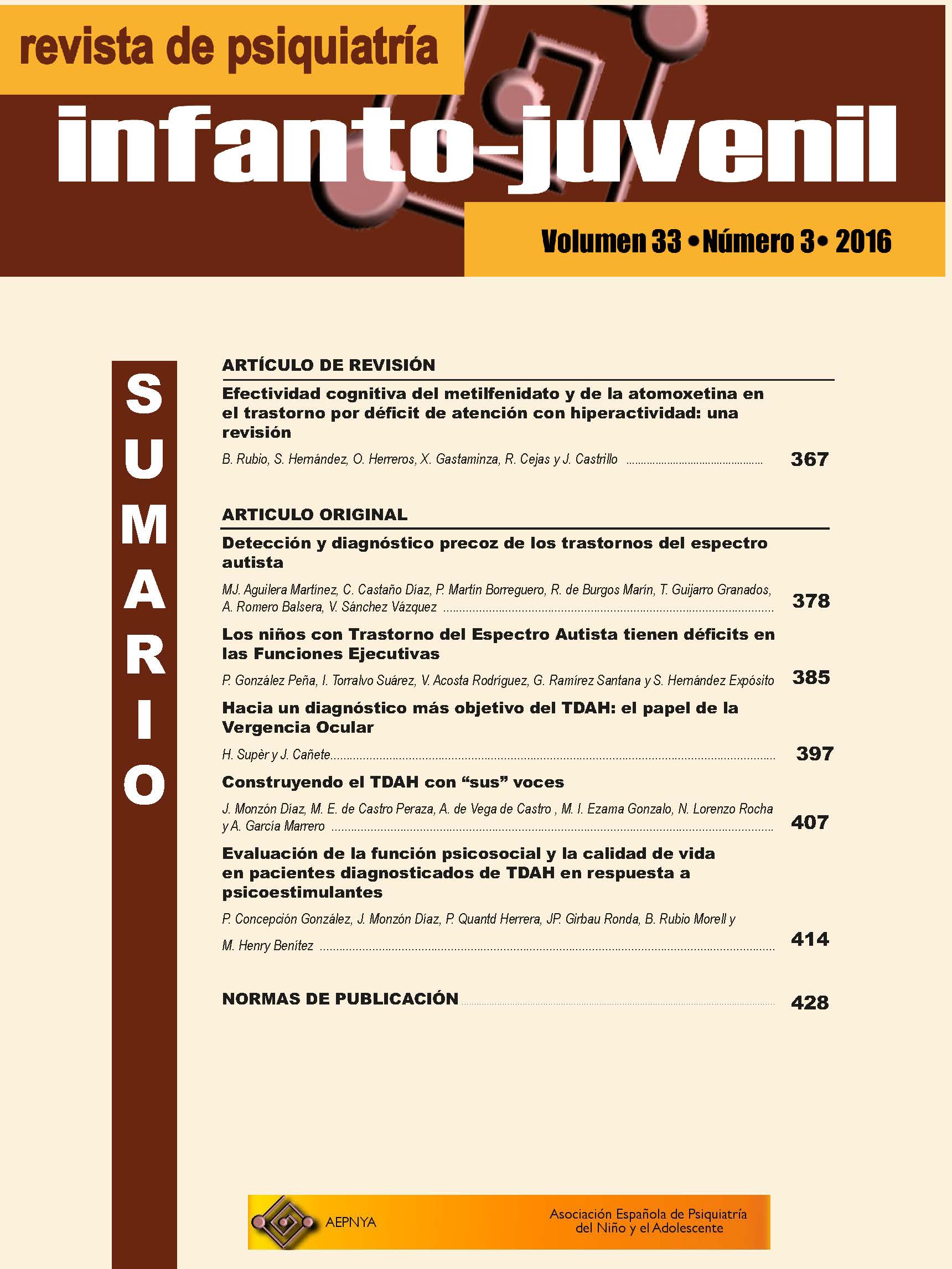Evaluación de la función psicosocial y la calidad de vida en pacientes diagnosticados de TDAH en respuesta a psicoestimulantes
Descargas
Publicado
Cómo citar
Número
Sección
DOI:
https://doi.org/10.31766/revpsij.v33n3a6Palabras clave:
TDAH, función psicosocial, deterioro funcional, psicoestimulantes, calidad de vida, WFIRS, GPIDResumen
Introducción: A pesar de que los tratamientos establecidos para mejorar los síntomas del TDAH han demostrado alivio sintomático significativo, es poco lo que se conoce sobre el efecto de los psicoestimulantes sobre el desarrollo psicosocial del niño y la potencial mejoría del deterioro funcional del paciente en todos los ámbitos de su vida diaria.
Objetivos: El objetivo principal de este estudio es evaluar el impacto del tratamiento farmacológico con psicoestimulantes en el deterioro funcional, las dificultades psicosociales y la calidad de vida de los pacientes diagnosticados de TDAH.
Material y métodos: Se realizó un estudio descriptivo, prospectivo, de una serie de casos, donde la población de estudio fueron 13 niños de entre 6 y 16 años, diagnosticados de TDAH en el Complejo Hospitalario Universitario de Canarias y que requerían comenzar tratamiento farmacológico con psicoestimulantes (Metilfenidato). El deterioro funcional y la calidad de vida fueron evaluados en respuesta al tratamiento pautado mediante dos instrumentos de valoración psicológica específicos para este trastorno: la Escala de Impresión Global de las Dificultades Percibidas (GIPD) y la Escala de Clasificación del Deterioro Funcional de Weiss (WFIRS).
Resultados: La evaluación de la puntuación total de las escalas GIPD y WFIRS efectuadas por los padres mostró mejoría en el desarrollo psicosocial entre el momento previo al tratamiento y tras ocho semanas de terapia farmacológica psicoestimulante. El estudio estadístico mostró un p-valor =0,000241 para las dificultades percibidas con la escala GIPD y un p =0,000152 para los cambios percibidos con la escala WFIRS, mostrando, por tanto, diferencias estadísticamente significativas.
Conclusión: En función de las respuestas de los padres obtenidas en las escalas, establecemos que los beneficios del tratamiento diario con psicoestimulantes en los niños con TDAH se extienden más allá del alivio de los síntomas e impacta positivamente en la función psicosocial diaria de los pacientes, así como en su calidad de vida.
Descargas
Citas
2. Gajria K, Kosinski M, Sikirica V, Huss M, Livote E, Reilly K, Dittmann RW, Erder MH. Psychometric validation of the Weiss Functional Impairment Rating Scale-Parent Report Form in children and adolescents with attention-deficit/hyperactivity disorder. Health and Quality of Life Outcomes. 2015; 13(1): 184.
3. American Psychiatric Association. Manual Diagnóstico y Estadístico de los Trastornos Mentales (DSM-V), 5ª Ed. Madrid: Editorial Médica Panamericana; 2014.
4. Polanczyk G, de Lima MS, Horta BL, Biederman J, Rohde LA. The worldwide prevalence of ADHD: a systematic review and metaregression analysis. The American Journal of Psychiatry. 2007; 164: 942–8.
5. Polanczyk G, Salum GA, Sugaya LS, et al. Annual research review: a meta-analysis of the worldwide prevalence of mental disorders in children and adolescents. J Child Psychol Psychiatry 2015; 56(3): 345-65.
6. Barkley RA. The Nature of ADHD. History. En: Barkley RA, editor. Attention-Deficit Hyperactivity Disorder. A Handbook for diagnosis and treatment. 3ª ed. London: The Guilford Press; 2006. pp. 3-75.
7. American Psychiatric Association. Manual Diagnóstico y Estadístico de los Trastornos Mentales (DSM-IV-TR), 4ª Ed. Barcelona: Masson; 2001.
8. World Health Organization. International statistical classification of diseases and related health problems. - 10th revision, 5th edition, 2016.
9. Criado Álvarez J, Romo B. Variability and tendencies in the consumption of methylphenidate in Spain. An estimation of the prevalence of attention deficit hyperactivity disorder. Rev Neurol. 2003; 37(9):806-10.
10. Barkley RA, Fischer M, Smallish L, Fletcher K. The Persistence of Attention-Deficit/Hyperactivity Disorder into Young Adulthood as a Function of Reporting Source and Definition of Disorder. Journal of Abnormal Psychology. 2002; 111(2): 279–289.
11. Thomas E. Brown. Trastorno por Déficit de Atención (Una mente desenfocada en niños y adultos). Barcelona: Masson; 2006.
12. Ernst, M., A.J. Zametkin, et al. High Midbrain DOPA accumulation in children with attentiondeficit Hyperactivity Disorder. American Journal of Psychiatry. 1999; 56(8): 1209-1215.
13. Soutullo Esperón C, Díez Suárez A. Manual de diagnóstico y tratamiento del TDAH. Madrid: Editorial Médica Panamericana. 2007.
14. Fernández-Jaén, A., López-Martín, S., Albert, J., Fernández-Mayoralas, D., Fernández-Perrone, A., de La Peña, M., Calleja-Pérez, B., Rodríguez, M., López-Arribas, S. and Muñoz-Jareño, N. Cortical thickness differences in the prefrontal cortex in children and adolescents with ADHD in relation to dopamine transporter (DAT1) genotype. Psychiatry Research: Neuroimaging 2015, 233(3): 409-17.
15. Grupo de trabajo de la Guía de Práctica Clínica sobre el Trastorno por Déficit de Atención con Hiperactividad (TDAH) en Niños y Adolescentes. Fundació Sant Joan de Déu, coordinador. Guía de Práctica Clínica sobre el Trastorno por Déficit de Atención con Hiperactividad (TDAH) en Niños y Adolescentes. Plan de Calidad para el Sistema Nacional de Salud del Ministerio de Sanidad, Política Social e Igualdad. Agència d´Informació,
Avaluació i Qualitat (AIAQS) de Cataluña; 2010. Guías de Práctica Clínica en el SNS: AATRM Nº 2007/18.
16. Faraone SV, Mick E. Molecular genetics of attention deficit hyperactivity disorder. Psychiatric Clinics of North America. 2010; 33: 159-180.
17. Hidalgo Vicario MI, Soutullo Esperón C. Trastorno por déficit de atención e hiperactividad. En: Muñoz Calvo M, Hidalgo Vicario M, Clemente Pollán J. Pediatría Extrahospitalaria. Fundamentos clínicos en Atención Primaria. 4ª ed. Madrid: Ergon; 2008.
18. Thapar A, Cooper M. Attention Deficit Hyperactivity Disorder. The Lancet. 2016; 387(10024): 1240-50.
19. Jensen PS, Hinshaw SP, Swanson JM, et al. Findings from the NIMH multimodal treatment study of ADHD (MTA): implications and applications for primary care providers. J Dev Behav Pediatr. 2001; 22: 20-73.
20. Banaschewski T, Johnson M, Lecendreux M, Zuddas A, Adeyi B, Hodgkins P, Squires LA, Coghill DR. Health-Related Quality of Life and Functional Outcomes from a Randomized-Withdrawal Study of Long-Term Lisdexamfetamine Dimesylate Treatment in Children and Adolescents with Attention-Deficit/Hyperactivity Disorder. CNS Drugs. 2014; 28: 1191–1203.
21. Bradley C. The behavior of children receiving Benzedrine. The American Journal of Psychiatry. 1937; 94: 577–585.
22. Cardo E, Porsdal V, Quail D, Fuentes J, Steer C, Montoya A, Anand E, Escobar R. Fast vs. Slow Switching from Stimulants to Atomoxetine in Children and Adolescents with Attention-Deficit/Hyperactivity Disorder. Journal of Child and Adolescent Psychopharmacology. 2013; 23(4): 252-261.
23. Graham J, Banaschewski T, Buitelaar J, Coghill D, Danckaerts M, Dittmann RW, Dopfner M, Hamilton R, Hollis C, Holtmann M, Hulpke-Wette M, Lecendreux M, Rosenthal E, Rothenberger A, Santosh P, Sergeant J, Simonoff E, Sonuga-Barke E, Wong IC, Zuddas A, Steinhausen HC, Taylor E. European guidelines on managing adverse effects of medication for ADHD. Eur. Child Adolesc. Psychiatry. 2011; 20: 17–37.
24. Shang CY, Pan YL, Lin HY, Huang LW, Gau SS. An Open-Label, Randomized Trial of Methylphenidate and Atomoxetine Treatment in Children with Attention-Deficit/Hyperactivity Disorder. Journal of Child and Adolescent Psychopharmacology. 2015; 25(7): 566-573.
25. Hawkey E, Nigg JT. Omega-3 fatty acid and ADHD: blood level analysis and meta-analytic extension of supplementation trials. Clin Pychol Rev. 2014; 34: 496-505.
26. Grogan K, Bramham, J. Demographic, developmental and psychosocial predictors of the development of anxiety in adults with ADHD. ADHD Attention Deficit and Hyperactivity Disorders. 2015; 8(1): 35-44.
27. Gibbs, E., Kass, A., Eichen, D., Fitzsimmons-Craft, E., Trockel, M. and Wilfley, D. Attentiondeficit/hyperactivity disorder–specific stimulant misuse, mood, anxiety, and stress in college-age women at high risk for or with eating disorders. Journal of American College Health. 2016; 64(4): 300-308.
28. Belendiuk K, Pedersen S, King K, Pelham W, Molina B. Change over time in adolescent and friend alcohol use: Differential associations for youth with and without childhood attention-deficit/hyperactivity disorder (ADHD). Psychology of Addictive Behaviors. 2016; 30(1): 29-38.
29. Dittmann RW, Wehmeier PM, Schacht A, Lehmann M, Lehmkuhl G. Self-esteem in adolescent patients with attention-deficit/hyperactivity disorder during open-label atomoxetine treatment: psychometric evaluation of the Rosenberg Self-Esteem Scale and clinical findings. ADHD Attention Deficit Hyperactive Disorder. 2009; 1:187–200.
30. Hechtman L, Greenfield B. Long-term use of stimulants in children with attention deficit hyperactivity disorder. Pediatr Drugs. 2003; 5:787–794.
31. Wehmeier PM, Schacht A, Dittmann RW, Doepfner M. Global impression of perceived difficulties in children and adolescents with attention-deficit/hyperactivity disorder: Reliability and validity of a new instrument assessing perceived difficulties from a patient, parent and physician perspective over the day. Child Adolesc Psychiatry Ment Health. 2008; 2:10.
32. Dittmann RW, Banaschewski T, Schacht A, Wehmeier PM. Findings from the observational COMPLY study in children and adolescents with ADHD: core symptoms, ADHD-related difficulties, and patients’ emotional expression during psychostimulant or nonstimulant ADHD treatment. Attention Deficit Hyperactive Disorder. 2014; 6(4):291-302.
33. Dittmann RW, Wehmeier PM, Schacht A, Minarzyk A, Lehmann M, Sevecke K and Lehmkuhl G. Atomoxetine treatment and ADHDrelated difficulties as assessed by adolescent patients, their parents and physicians. Child and Adolescent Psychiatry and Mental Health. 2009; 3:21.
34. Canadian Attention Deficit Hyperactivity Disorder Resource Alliance (CADDRA): Canadian ADHD Practice Guidelines. 3rd Ed. Toronto ON; CADDRA, 2011.
35. Nagy P, Häge A, Coghill DR, Caballero B, Adeyi B, Anderson CS, Sikirica V, Cardo E. Functional outcomes from a headtohead, randomized, doubleblind trial of lisdexamfetamine dimesylate and atomoxetine in children and adolescents with attentiondeficit/hyperactivity disorder and an inadequate response to methylphenidate. Eur Child Adolesc Psychiatry. 2016; 25:141–149.
36. Weiss MD, Brooks BL, Iverson GL, Lee B, Dickson R, Wasdell M. Reliability and validity of the Weiss functional impairment rating scale. Presented at: AACAP 54th Annual Meeting, Boston, MA, 23-28 October 2007.
37. Tarakç?o?lu MC, Memik NÇ, Olgun NN, Aydemir Ö, Weiss MD. Turkish validity and reliability study of the Weiss Functional Impairment Rating Scale-Parent Report. Attention Deficit Hyperactive Disorder. 2015; 7(2):129-39.
38. Banaschewski T, Soutullo C, Lecendreux M, Johnson M, Zuddas A, Hodgkins P, Adeyi B, Squires LA, Coghill D. Health-Related Quality of Life and Functional Outcomes from a Randomized, Controlled Study of Lisdexamfetamine Dimesylate in Children and Adolescents with Attention Deficit Hyperactivity Disorder. CNS Drugs. 2013; 27:829–840.
39. Hervas A, Huss M, Johnson M, McNicholas F, Stralen J, Sreckovic S, Lyneg A, Bloomfieldg R, Sikiricah V, Robertsonh B. Efficacy and safety of extended-release guanfacine hydrochloride in children and adolescents with attention-deficit/hyperactivity disorder: A randomized, controlled, Phase III trial. European Neuropsychopharmacology. 2014; 24(12): 1861–1872.
40. Epstein J, Weiss M. Assessing treatment outcomes in attention-deficit/hyperactivity disorder: a narrative review. Prim Care Companion CNS Disord. 2012.
41. Xia W, Shen L, Zhang J. Comorbid anxiety and depression in school-aged children with attention deficit hyperactivity disorder (ADHD) and self-reported symptoms of ADHD, anxiety, and depression among parents of school-aged children with and without ADHD. Shanghai Arch Psychiatry. 2015; 27(6): 356–367.









 © 2021 AEPNyA Todos los derechos reservados
© 2021 AEPNyA Todos los derechos reservados
